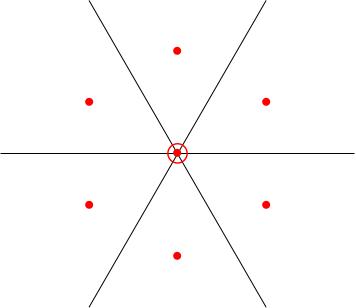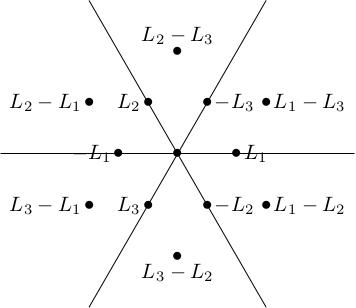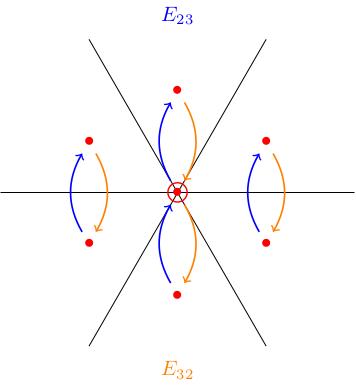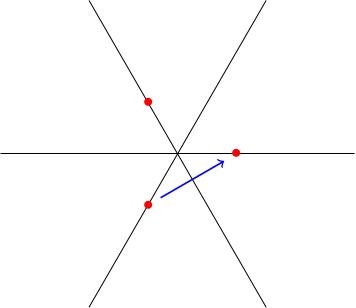We will change notation slightly and write W_(k l) equals W_(lambda) where lambda of theta equals k theta_1 plus l theta_2. Bundling the two integers together in this way will make life easier in future (e.g. when we have more than two integer weights).
Root vectors acting on weight spaces
Review
Given a representation R from SU(3) to G L V, we have seen that V equals the direct sum of weight spaces W_(k l) where k and l are integers and W_(k l) is the set of v in V such that R of the diagonal matrix e to the i theta_1, e to the i theta_2, e to the minus i (theta_1 plus theta_2) applied to v equals e to the i (k theta_1 plus l theta_2) times v or equivalently W_(k l) is the set of v in V such that R star superscript C of the diagonal matrix theta_1, theta_2, minus theta_1 minus theta_2 applied to v equals (k theta_1 plus l theta_2) times v.
Remember that the diagonal matrix theta_1, theta_2, minus theta_1 minus theta_2 isn't in little s u 3, rather it's in little s l 3 C, the complexification of little s u 3, which is why we're using R star superscript C.
We were drawing the weights (k, l) on a triangular lattice. For example, the weight diagram for the adjoint representation was:

Define L_1 of theta to be theta_1, L_2 of theta to be theta_2, L_3 of theta to be theta_3, which is minus theta_1 minus theta_2. These are the lambdas corresponding to (k, l) equals (1, 0), (0, 1), and (minus 1, minus 1) respectively.
With this notation, the weights of the standard representation are L_1, L_2, L_3 and the weights of the adjoint representation are L_i - L_j because little ad H_(theta) E_{i j} equals (theta_i minus theta_j) times E_{i j}.

The analogue of X and Y
Statement
For little s l 2 C, the adjoint representation has weight spaces W_(minus 2) spanned by Y, W_0 spanned by H and W_2 spanned by X. The elements X and Y played an important role in studying the representations of SU(2): X moved vectors from weight spaces with weight k to weight spaces with weight k + 2 and Y moved them back again.
The analogue for SU(3) will be to see how the weight vectors E_{i j} in little s l 3 C of the adjoint representation act on the weight spaces of another representation.
Given a complex representation R from S U 3 to G L V, R star superscript C of E_{i j} sends W_lambda to W_(lambda plus L_i minus L_j).
Example: Adjoint representation
We illustrate the lemma in the figures below, showing how the matrices R star superscript C of E_{i j} act in the adjoint representation. For example R star superscript C of E_{1 3} and R star superscript C of E_{3 1} translate weight spaces forwards and backwards along the L_1 - L_3 direction.



Example: standard representation
The figure below shows the standard representation. There are three weights L_1, L_2, L_3. Let's see how E_{1 3}= 0, 0, 1; 0, 0, 0; 0, 0, 0 acts. It sends e_1 in W_{L_1} and e_2 in W_{L_2} to zero and it sends e_3 in W_{L_3} to e_1 in W_{L_1}. Correspondingly, we draw an arrow in the L_3 - L_1-direction in the weight diagram, as dictated by the lemma.
We know that E_{1 3} sends W_{L_1} to W_{2 L_1 - L_3} by the lemma, but W_{2 L_1 - L_3} = 0 which is why E_{1 3} e_1 = 0. In terms of the figure, the vector L_1 - L_3 starting at L_1 ends at a lattice point which is not in the weight diagram.

Proof of lemma
If v is in W_(lambda) then we need to show R star superscript C of E_{i j} applied to v is in W_{lambda plus L_i minus L_j}.
We have v in W_lambda if and only if R star superscript C of H_theta applied to v equals lambda of theta times v.
We have R star superscript C of E_{i j} applied to v is in W_{lambda plus L_i minus L_j} if and only if R star superscript C of H_theta times R star superscript C E_{i j} applied to v equals (lambda of theta plus thet_i minus theta_j) times R star superscript C of E_{i j} applied to v.
We have H_theta bracket E_{i j} equals little ad H_theta applied to E_{i j}, which equals (theta_i minus theta_j) times E_{i j}, because E_{i j} is in the L_i minus L_j weight space of the adjoint representation. Applying R star superscript C we get R star superscript C of (H_theta bracket E_{i j} equals R star superscript C of H theta bracket with R star superscript C of E_{i j}, which equals theta_i minus theta_j times R star superscript C of E_{i j}.
Therefore R star superscript C of H theta, times R star superscript C of E_{i j}, applied to v equals R star superscript C of E_{i j}, times R star superscript C of H_theta applied to v; plus (theta_i minus theta_j) times R star superscript C of E_{i j} applied to v.
Since v is in W_lambda, we have R star superscript C of H_theta applied to v equals lambda of theta times v, so R star superscript C of H_theta, times R star superscript C of E_{i j}, applied to v equals (lambda of theta plus theta_i minus theta_j) times R star superscript C of E_{i j} applied to v This shows that R star superscript C of E_{i j} applied to v is in W_(lambda plus L_i minus L_j) as required.
We have used two crucial things:
-
R star superscript C is a representation
-
little ad of H theta applied to E_{i j} equals (theta_i minus theta_j) times E_{i j}, in other words, E_{i j} is a root vector with root L_i minus L_j.
The same proof shows more generally that if X in little g is a weight vector of the adjoint representation (root vector) with weight (root) alpha then X sends weight vectors in W_lambda (for any representation) to weight vectors in W_(lambda plus alpha).
Pre-class exercises
What do you think the weight diagram of the standard 4-dimensional representation of SU(4) would look like? How do you think the matrices E_{i j} act?